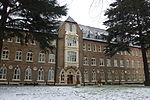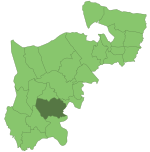West Thames College
Education in the London Borough of HounslowFurther education colleges in LondonIsleworth
West Thames College is a medium-sized college of further and higher education in West London, England. It was formed in 1976, originally named Hounslow Borough College, having gained its current name in 1993. The college has two campuses in the London Borough of Hounslow: a main campus in Isleworth and a smaller Skills Centre in Feltham. As of 2014 there were over 5,200 enrolled students at the college. The college offers a wide range of A Levels and specialist vocational courses up to higher education level: BTECs, NVQs, City & Guilds, Foundation Degrees and HNDs.
Excerpt from the Wikipedia article West Thames College (License: CC BY-SA 3.0, Authors).West Thames College
London Road, London Spring Grove (London Borough of Hounslow)
Geographical coordinates (GPS) Address Phone number Website External links Nearby Places Show on map
Geographical coordinates (GPS)
| Latitude | Longitude |
|---|---|
| N 51.4753 ° | E -0.3423 ° |
Address
West Thames College
London Road
TW7 4HS London, Spring Grove (London Borough of Hounslow)
England, United Kingdom
Open on Google Maps







